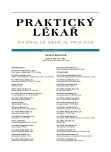Prenatal diagnostics of the most frequent chromosomal aberrations
Authors:
H. Kuželová; M. Macek Jr.
Published in:
Prakt. Lék. 2011; 91(7): 392-395
Category:
Various Specialization
Overview
Prenatal diagnostics has greater importance/bearing in current medicine and medical practice. Many serious disorders and congenital defects are connected with chromosomal aberrations. Prenatal diagnostics detects these chromosomal aberrations. Understanding the possibilities and principles of prenatal diagnostics is important for medical doctors of all professions – because it helps with the understanding of modern medical methods and the aetiology of these disorders.
Key words:
prenatal diagnostics, chromosomal aberrations, congenital defects, QF-PCR (quantitative fluorescent polymerase chain reaction).
Sources
1. Bob, P., Ptacek, R., Pavlat, J., et al. Symptoms of complex partial epilepsy in depression and possibilities of prediction for anticonvulsants. Homeost. Health Dis. 2004, 43(1), p. 30-32.
2. Bob, P., Ptáček, R., Paclt, I. a kol. Disociace a symptomy komplexní parciální epilepsie u depresivních pacientů. Česká a Slov. Psychiatr. 2003, 99(2), s. 82-88.
3. Bob, P., Ptáček, R. Disociativní komponenty v etiopatogenezi epilepsie a možnosti jejich sledování. Česk. Psychol, 2001, 45(4), s. 347-353.
4. Brown, L., Abigania, M., Warburton, D., Brown, S. Validation of QF-PCR for prenatal aneuploidy screening in the United States. Prenat. Diagn. 2006, 26, p. 1068–1074.
5. Calda, P. Prenatální diagnostika vrozených vývojových vad. In: Roztočil A. et al. Moderní porodnictví. Praha: Grada, 2008, s. 66-72.
6. Faber, J., Bob, P., Ptáček, R., Petránek, S. Dissociation and epilepsy. Psychiatrie 2001, 5 (1), p. 4-10.
7. Ford, C.E., Jones, K.W., Polani, P.E., Briggs, J.H. A sex-chromosome anomaly in a case of gonadal dysgenesis (Turner’s syndrom). Lancet 1959, 1, p. 711-713.
8. Glaslova, K., Bob, P., Jasova, D. et al. Traumatic stress and schizophrenia. Neurology Psychiatry and Brain Research 2004, 11 (4), p. 205-208.
9. Hájek, Z., Kulovaný, E., Macek, M. Základy prenatální diagnostiky. Praha: Grada, 2000.
10. Jacobs, P., Dalton, P., James, R. Turner syndrome: a cytogenetic and molecular study. Am. J. Hum. Genet. 1997, 61, p. 471-483
11. Kočárek, E., Maříková, T., Novotná, D. Vybrané kapitoly z lékařské cytogenetiky a lékařského poradenství. Praha: Ústav biologie a lékařské genetiky FN Motol a UK 2. LF, 2004.
12. Kream, R.M., Stefano, G.B., Ptáček, R. Psychiatric implications of endogenous morphine: Up-to-date review. Folia Biol. 2010, 56(6), p. 231-241.
13. Macek M., Krejsová A., Horká I., et al. Quantitative Fluorescent PCR (QFPCR) in the Examination of Microquantity of Fetal Cells. Early Prenatal Diagnosis, Fetal Cells and DNA in the Mother, Pressent State and Perspectives, 12th Fetal Cell Workshop, Prague, 2001, p. 304-328.
14. Mann, K., Ogilvie, C., Danaghue, C., et al. Professional Guidelines for clinical cytogenetics and clinical molecular genetics. Association for Clinical Cytogenetics and Clinical Molecular Genetics Society, QF-PCR for the diagnosis of aneuploidy best practice guidelines v2.01. 2007.
15. Mouatassima, M., Beckera, S., Kuziob, C. et al. Prenatal Diagnosis of Common Aneuploidies Using Multiplex Quantitative Fluorescent. Polymerase Chain Reaction. Fetal Diagn. Ther. 2004, 19, p. 496–503.
16. Prihodova, I., Paclt, I., Kemlink, D. et al. Sleep disorders and daytime sleepiness in children with attention-deficit/hyperactivity disorder: A two-night polysomnographic study with a multiple sleep latency test. Sleep. Medicine 2010, 11 (9), p. 922-928.
15. Pritchard, D.J., Korf, B.R. Medical Genetics at a Glance. 2nd Ed. John Wiley and Sons Ltd., 2007.
16. Ptáček, R., Pemová, T., Purrová, J., Čeledová, L. Potřeby rodin dětí se syndromem ADHD. Prakt. Lék., 2010, 90(5), s. 308-310.
17. Ptáček, R., Raboch, J. Určení rozsahu souboru a power analýza v psychiatrickém výzkumu. Česká a Slov. Psychiatr. 2010, 106(1), s. 33-41.
18. Ptáček, R., Bob, P. Metody diagnostiky disociativních symptomů. Česká a Slov. Psychiatr. 2009, 105(4), s. 163-172.
19. Ptacek, R., Bob, P., Paclt, I., et al. Psychobiology of dissociation and its clinical assessment. Neuroendocrinol. Lett. 2007, 28(2), p. 191-198.
20. Robinson, W.P. Mechanisms leading to uniparental disomy and their clinical consequences. Bioessays 2000, 22(5), p. 452–459.
21. Uher, T., Bob, P., Ptáček, R. Alexithymie a psychosomatická onemocnění. Česká a Slov. Psychol. 2010, 54(5), s. 496-504.
22. Zukov, I., Ptacek, R., Kozelek, P. et al. Brain wave P300: A comparative study of various forms of criminal activity. Med. Sci. Monit. 2009, 15(7), p. CR349-CR354.
23. Zukov, I., Ptacek, R., Fischer, S. EEG abnormalities in different types of criminal behavior. Act. Nerv. Super. 2008, 50(4), p. 110-113.
24. Žukov, I., Hrubý, T., Kozelek, P. et al. P300 wave: A comparative study of impulsive aggressive criminals. Neuroendocrinol. Lett. 2008, 29(3), p. 379-384.
Labels
General practitioner for children and adolescents General practitioner for adultsArticle was published in
General Practitioner

2011 Issue 7
- Metamizole at a Glance and in Practice – Effective Non-Opioid Analgesic for All Ages
- Memantine in Dementia Therapy – Current Findings and Possible Future Applications
- Advances in the Treatment of Myasthenia Gravis on the Horizon
- Possibilities of Using Metamizole in the Treatment of Acute Primary Headaches
- Hope Awakens with Early Diagnosis of Parkinson's Disease Based on Skin Odor
Most read in this issue
- Cystic tumours of the pancreas – an up-to-date review
- Prenatal diagnostics of the most frequent chromosomal aberrations
- Acute endoscopic treatment of upper gastrointestinal bleeding: twenty-one-years experience
- The health risk of an excessive intake of fructose
